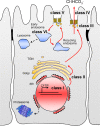From CFTR biology toward combinatorial pharmacotherapy: expanded classification of cystic fibrosis mutations
- PMID: 26823392
- PMCID: PMC4751594
- DOI: 10.1091/mbc.E14-04-0935
From CFTR biology toward combinatorial pharmacotherapy: expanded classification of cystic fibrosis mutations
Abstract
More than 2000 mutations in the cystic fibrosis transmembrane conductance regulator (CFTR) have been described that confer a range of molecular cell biological and functional phenotypes. Most of these mutations lead to compromised anion conductance at the apical plasma membrane of secretory epithelia and cause cystic fibrosis (CF) with variable disease severity. Based on the molecular phenotypic complexity of CFTR mutants and their susceptibility to pharmacotherapy, it has been recognized that mutations may impose combinatorial defects in CFTR channel biology. This notion led to the conclusion that the combination of pharmacotherapies addressing single defects (e.g., transcription, translation, folding, and/or gating) may show improved clinical benefit over available low-efficacy monotherapies. Indeed, recent phase 3 clinical trials combining ivacaftor (a gating potentiator) and lumacaftor (a folding corrector) have proven efficacious in CF patients harboring the most common mutation (deletion of residue F508, ΔF508, or Phe508del). This drug combination was recently approved by the U.S. Food and Drug Administration for patients homozygous for ΔF508. Emerging studies of the structural, cell biological, and functional defects caused by rare mutations provide a new framework that reveals a mixture of deficiencies in different CFTR alleles. Establishment of a set of combinatorial categories of the previously defined basic defects in CF alleles will aid the design of even more efficacious therapeutic interventions for CF patients.
© 2016 Veit et al. This article is distributed by The American Society for Cell Biology under license from the author(s). Two months after publication it is available to the public under an Attribution–Noncommercial–Share Alike 3.0 Unported Creative Commons License (http://creativecommons.org/licenses/by-nc-sa/3.0).
Figures


References
-
- Boucher RC. Airway surface dehydration in cystic fibrosis: pathogenesis and therapy. Annu Rev Med. 2007;58:157–170. - PubMed
Publication types
MeSH terms
Substances
Grants and funding
- N01-HL28187/HL/NHLBI NIH HHS/United States
- GM75061/GM/NIGMS NIH HHS/United States
- R01 DK068196/DK/NIDDK NIH HHS/United States
- P30 DK072482/DK/NIDDK NIH HHS/United States
- R01 GM56981/GM/NIGMS NIH HHS/United States
- P30 DK079307/DK/NIDDK NIH HHS/United States
- DK075302/DK/NIDDK NIH HHS/United States
- P30 DK072506/DK/NIDDK NIH HHS/United States
- R01-DK068196/DK/NIDDK NIH HHS/United States
- HL095524/HL/NHLBI NIH HHS/United States
- R01 DK075302/DK/NIDDK NIH HHS/United States
- AHL-14-007.001/PHS HHS/United States
- DK51870/DK/NIDDK NIH HHS/United States
- R01 GM056981/GM/NIGMS NIH HHS/United States
- Canadian Institutes of Health Research/Canada
- R01 GM075061/GM/NIGMS NIH HHS/United States
- R01 HL095524/HL/NHLBI NIH HHS/United States
- R01 GM067785/GM/NIGMS NIH HHS/United States
- P30-DK072506/DK/NIDDK NIH HHS/United States
- R01 DK051870/DK/NIDDK NIH HHS/United States
- R01 DK044003/DK/NIDDK NIH HHS/United States
LinkOut - more resources
Full Text Sources
Other Literature Sources
Medical

